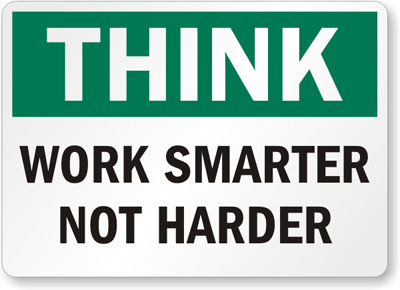by Vince Fabra
Have you ever heard that expression “Work smart not hard”?
 When I work with fraternity men, at least the ones who choose to work at all, they seem to be hard workers when it comes to recruitment. They are planning recruitment events, inviting potential new members to the events, furiously calling and texting their brothers to make sure they are coming to the event, grabbing ice, manning the barbecue pit, talking to guys, GOING CRAZY BECAUSE YOUR CHAPTER BROTHERS ARE EATING ALL THE FREE FOOD AND TALKING TO EACH OTHER. Let’s get smart!
When I work with fraternity men, at least the ones who choose to work at all, they seem to be hard workers when it comes to recruitment. They are planning recruitment events, inviting potential new members to the events, furiously calling and texting their brothers to make sure they are coming to the event, grabbing ice, manning the barbecue pit, talking to guys, GOING CRAZY BECAUSE YOUR CHAPTER BROTHERS ARE EATING ALL THE FREE FOOD AND TALKING TO EACH OTHER. Let’s get smart!
Planning recruitment events sucks.
My suggestion: Part 1. Stop planning recruitment events. It takes so much time, a lot of money (depending on the event) and requires that all of your brothers pitch in and help out (“I think I just saw a unicorn”).
My suggestion: Part 2. Start going to events planned by other people. Every campus has a Campus Activities Council that plans fun and free events for students on their campus. It might be a comedian, a musician, a game show, a video game tournament, a lecture on an interesting topic, or any other event that you probably ignored this semester. The Campus Activities Council is always looking to reach more students with their programming, and you are tired of running yourself ragged by planning and executing your own events. HMMM…! How about you just hitch your wagon to their wheel? Meaning, invite people from the names list, not to your chapter house for the fun event, but to the student union/quad/dorm/auditorium for a free night of fun.
Also, you know all of those brotherhood, service, social, philanthropy, your exoteric rituals and intramurals that already fill your calendar? Those are great opportunities to invite people with whom you have a mutual interest. The best way for potential joiners to learn about the organization is by witnessing the organization in a realistic group setting. Rather than standing around on your back deck eating hamburgers and hotdogs, with every member asking every potential new member “Where ya from,” “What’s your major,” “Did you play any sports in high school,” show them what fraternity looks like in a real way.
Pretty soon you can stop planning recruitment events, wasting time and money and you’ll be working smart not hard.
by Vince Fabra
Quick question… quick but heavy question… quick, heavy and important question…
Why do people join?
Why do people join anything – Fraternities, sororities, church groups, military, sports teams, email chains, cults?
There are so many ways to answer this question about people’s motivation to join organizations. However, I feel the best way to simply answer this question is to simply break down what an organization is – PEOPLE and PURPOSE. Joiners usually are signing up, clicking subscribe, pledging their loyalty because of one of these two things. PEOPLE and PURPOSE.
Here is another quick, heavy and important question…
Are our chapters recruiting with PEOPLE and PURPOSE?
Fraternity and sorority recruitment is most visible when we try to grab the attention of the potential joiners on our campuses. Banners in the student union, sidewalk chalk, A-Frame signs and makeshift bed sheet banners outside of a fraternity house window are just a few manifestations of fraternity and sorority marketing. Is that PEOPLE and PURPOSE?
Marketing is fine. However, marketing is only effective when it is highlighting PEOPLE and PURPOSE:
1. Marketing should help you meet new PEOPLE.
2. Marketing should clarify your PURPOSE to people you already know.
During my presentation training, I share the statement, “People join because of PEOPLE and PURPOSE” and everyone in the audience gives an agreeing nod. My guess is that most members of a values based organization would easily agree that PEOPLE and PURPOSE are the answers. But when I walk around college campuses, notice the common recruitment strategies and have conversations about recruitment, I don’t see much of PEOPLE and PURPOSE. We all agree that PEOPLE and PURPOSE is “where it’s at”, but we can be so easily distracted, spending our time/money/focus on everything but PEOPLE and PURPOSE.
My challenge to you – constantly challenge yourself and your organization to put PEOPLE and PURPOSE at the center of your recruitment efforts. If you are marketing your organization, having an information presentation, hosting a recruitment activity or event, or even participating in rush or formal recruitment, just ask yourself, “How does this reflect PEOPLE and PURPOSE?”
Power to the PEOPLE… and PURPOSE!